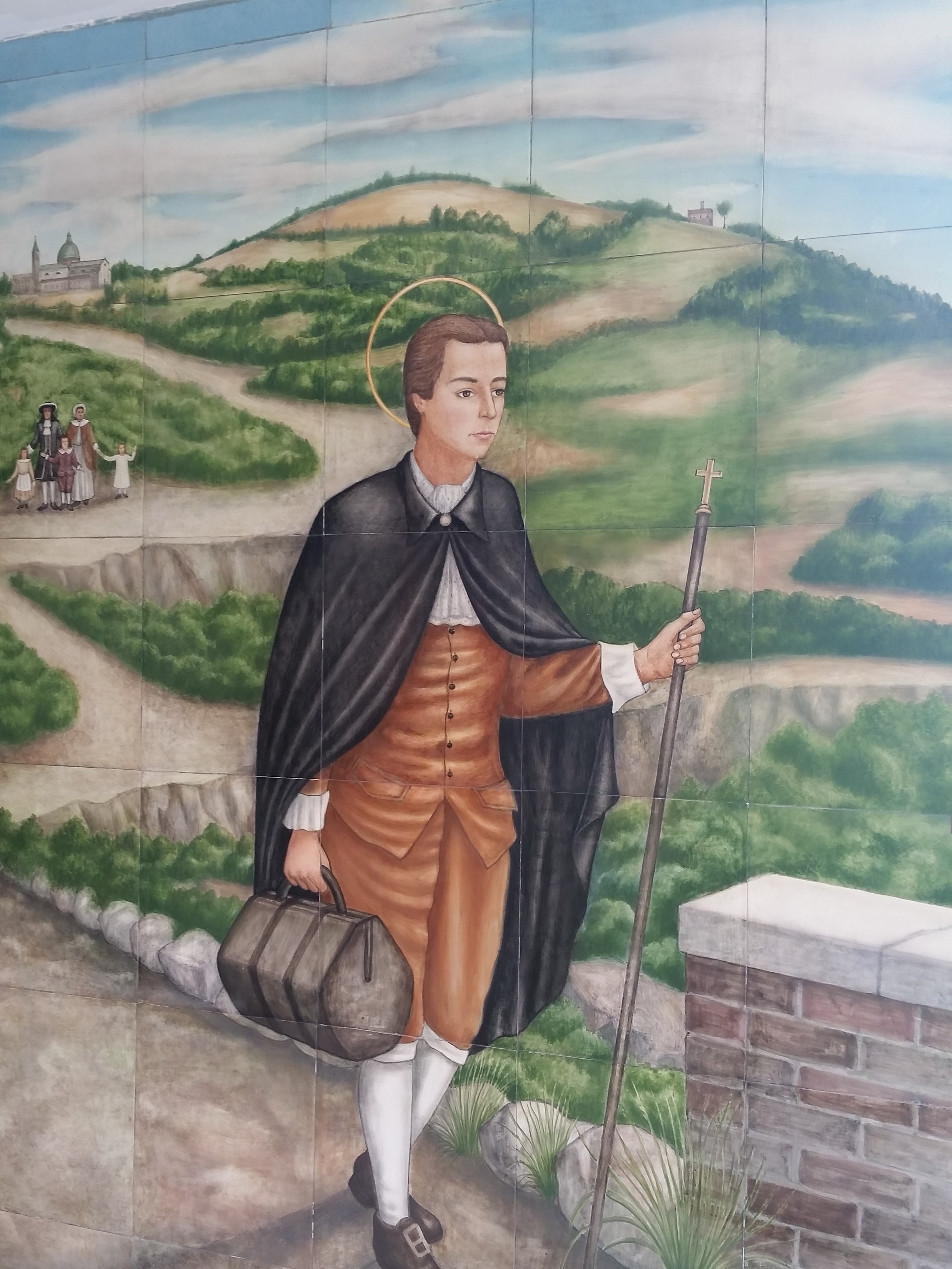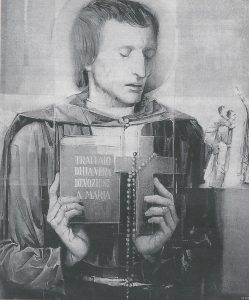Saint Louis Marie de Montfort
An Often Misunderstood Saint Part V: Silenced by Bishop Desmaretz of St. Malo
Fr. Patrick Gaffney, SMM
A fter his dismissal by Dom Leuduger, Father Louis Marie went back to his home territory. Not far from the village of Montfort was a medieval “Lazarus,” a former priory which, in earlier times, cared for homeless lepers. Over the years it had become more or less abandoned. When Louis Marie arrived, it was no more than a lodging for some poor farmers and for pilgrims passing through the area. It had a chapel attached to it although there had been no chaplain for eighteen years when Father de Montfort came upon the scene. Bordered by the enchanted forest of Borceliande, the old leper-house was in the midst of rare natural beauty, so appreciated by Montfort. A hermitage, ideal for a period of restful prayer! Since it appears that his father was responsible for the goods belonging to the ancient priory, Louis Marie had little difficulty moving in.
It was September, 1707. Louis de Montfort, his faithful companion, Brother Mathurin and a new recruit, Brother John, began what would become a year of community life, prayer and preaching. The chapel had been rebuilt in 1622; the group completely renovated it. Above the main altar Montfort painted a dove to represent the Holy Spirit, he carved a magnificent crucifix and a statue of Our Lady of Wisdom to kindle the devotion of all who would visit. A long prie-dieu with a massive fifteen decade rosary hanging from it invited people, even several at a time, to meditate on the mysteries of Jesus and Mary. Louis de Montfort, the missionary, even in his hermitage had to preach the Good News of Jesus Christ.
The St. Lazare retreat was, therefore, not off-limits to any individual or group seeking to deepen love for Jesus. As the news of Father Louis Grignion’s presence spread throughout the neighboring villages and towns, crowds so large came to hear the holy missionary that he often preached outdoors, under a huge oak tree in a field nearby. Montfort’s powerful, inspired sermons, his tenderness in the confessional, soon made St. Lazare a holy place of pilgrimage for the people in the area. The hermitage became a perpetual mission. And his fame grew as several parishes called upon him for sermons or retreats.
Strangely, quietly but intensely, opposition grew to Louis Grignion’s presence at St. Lazare. It was strange, for he was not only a Breton himself, but from the neighborhood and his parents now lived in the village of Couascavre, a short distance away. The complaints were not overt, there was never a demonstration outside the priory. But stories began to circulate especially among the clergy of the diocese. He’s the disgrace of St. Sulpice! Wasn’t he expelled from Poitiers? And even Dom Leuduger couldn’t get along with him! He’s a strange priest . . . it’s said that he has even boldly walked into houses of prostitution to convert everyone there! He’s lucky they haven’t yet succeeded in murdering him. And we’ve had enough with all those dangerous beggars and tramps going to visit him every day at St. Lazare! And some actually eat with him. . . .
These repeated tales reached the ears of the Bishop, Vincent François Desmaretz. And he may have had his own complaints against Father de Montfort. A former high ranking member of the military, the bishop was not appreciative of clergy who acted with independence, and even more so of a priest who was so rootless as Louis Grignion. It is reported by some biographers that the Bishop of St. Malo was known for his Jansenist tendencies and was, therefore, repelled by the saint’s insistence on the tenderness of God. However as will be seen in more detail, rigorism does not automatically equate with the complex heresy named Jansenism.
What is certain is that while visiting the Montfort deanery during the Fall of 1707, Bishop Desmaretz heard his clergy repeat tale after tale about that priest living at St. Lazare. Like an autocratic General, he summoned Father de Montfort to report to him immediately. Without a hearing, without any formal questioning, he summarily told Father Louis Grignion that he was forbidden to exercise any ministry in the diocese of St. Malo. What made the situation even more humiliating is that, so Blain states, the Bishop was surrounded with several priests who brought the complaint against Montfort and whose smirks gloated their victory.
Yet at that moment, Father Hindré, the former rector of one of the parishes at Montfort and now the pastor at Bréal, appeared
at the door. Having heard that the Bishop was in the area, he took the opportunity of requesting permission to have Father Louis Marie Grignion preach a mission to the young people of his parish. And surprised he was that Father Grignion happened to be there in the Bishop’s presence! Without letting on what had just transpired, Vincent-Francois Desmaretz replied to the highly respected Father Hindré, “’that’s fine.” And Montfort in his simple boldness, then went up to the Bishop and asked: “Would His Excellent also grant me the permission to hear the confessions of any others who may ask?” And again, the Bishop consented. The command issued to Louis de Montfort to cancel all ministry in the diocese of St. Malo was automatically rescinded.

Tile mural depicting a scene of St Louis de Montfort’s Life and a sketch from Our Italian Magazine
This mural (image #1) appears immediately outside the chapel in Montfort’s Spiritual Center. This first scene depicts Louis Grignion’s leaving to begin his studies in Paris. Louis Grignion walked to his destinations and this journey was no different. It is over 250 miles between the towns. He would give up his clothes and money along the way.
The second image is a sketch of St. Louis de Montfort from our Italian Magazine, Madre e Regina, published in Rome. The image shows Fr. de Montfort, the spiritual guide to Jesus, holding up three symbols of his well known writings: True Devotion to Mary, The Secret of the Most Holy Rosary, and Friends of the Cross. This image graced the Queen of All Hearts Magazine in May 1998.
The mission at Bréal was one of the most powerful Montfort preached. The pastor was so stunned at the amazing results that he expressed his surprise to Father Louis Marie. “I have walked more than two thousand leagues on pilgrimage to ask God for the grace to touch hearts and He has answered me,”
The mission at Bréal was one of the most powerful Montfort preached. The pastor was so stunned at the amazing results that he expressed his surprise to Father Louis Marie. “I have walked more than two thousand leagues on pilgrimage to ask God for the grace to touch hearts and He has answered me,” was the saint’s matter-of-fact reply.
However the success at Bréal only added to the resentment on the part of some of the clergy. Moreover, the story was out that Montfort, while at Bréal, had the audacity to storm uninvited into a house to break up a violent dispute between a husband and wife. He had heard the fearful screaming of a woman as he was walking by. He never doubted what he was to do. The husband, about to strike his wife with a cleaner, turned on the intruder and raised his arm to swing a fatal blow at the priest. The arm froze. He could only shout a litany of curses and blasphemies. The people’s admiration for Father de Montfort knew no bounds.
During the Spring of l708, Bishop Desmaretz visited the three parishes of the town of Montfort. Once again, he herd
story after story about the so-called hermit of St. Lazare. His order now was firm although in terms less severe. To make sure that the missionary’s influence would be greatly curtailed, if not completely arrested, the Bishop decreed that Father de Montfort could not proclaim God’s Word at the hermitage but only in parish churches which meant, of course, on the condition that the local Pastor would be agreeable. The parish priest would, therefore, assume full responsibility before the Bishop for anything Father Grignion said or did. No need to hire a soothsayer to divine the Bishop’s thought. Montfort left the diocese.
To Be Continued



